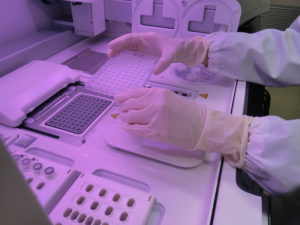
〇 High value-added by lactic acid bacteria and yeast (fermentation, functionality)
Lactic acid bacteria and yeasts, which have been used for fermentation since prehistoric times, provide food with preservation and deliciousness, as well as foods with added health functionality. Also, the health function of lactic acid bacteria and yeast itself has been known for a long time, but the mechanism is deep and the unknown world is still spreading.
Research theme
(1) Effect of lactic acid fermentation on food functionality of microalgae
(2) Isolation of lactic acid bacteria derived from fish intestinal tract and its functionality
(3) Improving the taste of fish and livestock by using lactic acid bacteria derived from the coastal environment and yeast fermented liquid
(4) Antibacterial activity of lactic acid bacteria derived from coastal environment
(5) Functionality of fermented soymilk using lactic acid bacteria derived from coastal environment
(6) Suppression of histamine accumulation in seafood using starter
(7) Addition value by fermenting argan oil oil residue

〇 Food (functional) ingredients and intestinal bacteria
There may be individual differences in what you eat and how good your stomach is. It is considered that there are individual differences in the indigenous bacteria (SIB) of the stomach that are susceptible to each food ingredient in the intestine. In addition to Bifidobacteria and lactic acid bacteria, which have been considered as useful bacteria, various useful bacteria candidates have been reported. We believe that these SIBs will lead to the development of tailor-made functional foods that will be needed in the future.
Research theme
(1) SIB specific to each protein (casein, egg white, soybean)
(2) Specific SIB for each administered lactic acid bacterium (probiotic)
(3) SIBs specific to each type of seaweed (Arame, Tsunomata, Astragalus etc.)
(4) SIB specific to each curry spice (turmeric, coriander, capsicum)
Next-generation sequencer was used to detect SIBs specific to each food, and some of them were successfully separated. Regarding isolated SIBs, we are studying the effects of the cells themselves on the host and the synergistic effect with each food ingredient

〇 Detection of foodborne pathogens and spoilage causative bacteria using molecular methods and tracing of contamination sources
Molecular biological methods such as PCR have become widely used. It is also widely used in the field of food, for example, to identify bacteria that cause food poisoning and bacteria that cause food spoilage. In addition to this, in recent years, devices such as next-generation sequencers and digital PCR, which have higher discriminating ability and speed, and which can perform sophisticated analysis have appeared. Our laboratory is researching new ways to use these new devices, aiming for high hygiene in the field of food production.
Research theme
(1) Development of a method for distinguishing live cells, dead cells, and injured cells using nucleic acid binding reagent (PMA)
(2) Development of quantitative method for food poisoning bacteria and food-related bacteria using digital PCR
(3) Development of a source tracking method for contaminant bacteria in food factories using a next-generation sequencer
(4) Simple and rapid identification method of strains using DNA typing method (MLST, MLVA method) and its application method

〇 Development of microbial growth control method using food-derived ingredients and extension of shelf life
Food loss is also included in the Sustainable Development Goals (SDGs) and is recognized as a global issue. In order to sell food, it is important that it does not decay and is safe from the time it is manufactured until it is sold. In recent years, various forms of food have been sold, but many of them are difficult to keep for a long time. Food will not spoil if it is completely free of bacteria. However, treatments that kill bacteria, including heating, significantly impair the flavor of food. Preservatives are an effective way to control microorganisms that have remained in foods, but the use of preservatives tends to be smoke-free by consumers. Our laboratory is searching for methods to suppress the growth of microorganisms, focusing on ingredients derived from foods, and developing practical methods that can extend the expiration date. We are also working on the effective use of large amounts of food residues discharged at food factories.
Research theme
(1) Development of a method for suppressing the growth of food poisoning bacteria and spoilage-causing bacteria by using rice bran-derived components
(2) Development of a method for inhibiting the growth of microorganisms using essential oils and a method for adding them to foods
(3) Development of new packaging technology with microbial control ability
(4) Study on behavioral analysis and control method of spoilage-causing yeast in food
(5) Extraction of new protein source derived from processing residues discharged from chicken processing plant

〇Study on behavior analysis and inactivation method of waterborne infectious disease virus
Viruses have behaviors that are completely different from bacteria, and different approaches are required for their control and inactivation methods. In our laboratory, norovirus, hepatitis A virus, etc. that infect via food behave in food production sites and processing plants, and what methods are effective to inactivate them. I am verifying. In these studies, we discovered a component that can inactivate the virus among the components derived from egg white and found a method to apply it to food. In order to further develop this research, we are developing a more efficient virus inactivating agent by conducting an inactivation mechanism and extracting the active site. Currently, this technology is put to practical use as a spray formulation and wet tissue, but we are also considering the formulation of a formulation that can be used for aquaculture and livestock farming at the site of fisheries.
Past research examples
(1) Application of inactivating ability of norovirus to food by high hydrostatic pressure treatment
(2) Study on virus transmission in food processing
(3) Inactivation of various viruses using heat-denatured lysozyme, a component derived from egg white
(4) Elucidation of inactivation mechanism of heat-denatured lysozyme and extraction of active site
(5) Study on virus inactivation method in aquaculture and livestock farming
